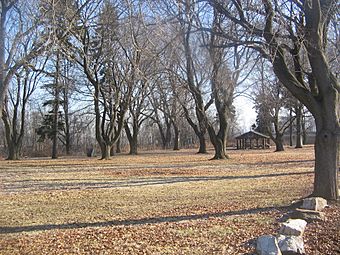Memorial Park Site facts for kids
Quick facts for kids |
|
|
Memorial Park Site
|
|

View of the park
|
|
| Location | South Water Street, Lock Haven, Pennsylvania |
|---|---|
| Area | 19 acres (7.7 ha) |
| NRHP reference No. | 82003783 |
| Added to NRHP | April 14, 1982 |
The Memorial Park Site (also known as 36CN164) is a special place where archaeologists have found old things. It's located in Lock Haven, Pennsylvania, right where two rivers meet: Bald Eagle Creek and the West Branch Susquehanna River. Since 1979, scientists have been studying this site. They have found items from people who lived here over 8,000 years ago!
Contents
Discovering Ancient History
Archaeologists study places like Memorial Park to learn about the past. They dig carefully to find objects and clues left by people long ago. At this site, they found many layers of history. Each layer tells a story about a different time period.
Layers of Time
The ground at Memorial Park is like a giant history book. Different layers of soil hold items from different times. This is called stratification. The oldest items are deep down, and the newer ones are closer to the surface.
- Middle Archaic Period: This is one of the oldest periods found here. It dates back thousands of years.
- Late Woodland Period: This is a more recent prehistoric time. It ended just before Europeans arrived.
The most important part of the site shows an ancient village. People from the Clemson Island culture lived here between 500 and 1000 CE. They built their homes and lived their lives in this spot.
Why This Spot Was Special
The area where Bald Eagle Creek meets the West Branch Susquehanna River was a great place to live. The two rivers created easy travel routes. This meant that ancient people from different areas could easily reach this spot. It was a perfect meeting place and home for many groups.
Ancient Squash Plants
Scientists found pieces of squash plants at the site. These pieces were used to figure out how old the layers were. This method is called radiocarbon dating. The squash found was a type called Cucurbita pepo.
What's cool is that this type of squash didn't grow wild nearby. This means the ancient people living here brought the squash with them on purpose. It shows they were farming or gathering plants from far away.
Protecting the Past
Memorial Park is a unique place because much of it has stayed untouched. Most other areas near the rivers have been built on. But this park has been protected.
How the Site Stayed Safe
The site is covered by a layer of dirt and sand called alluvial deposits. This layer is about 20 to 28 inches (50 to 70 cm) deep. It acted like a blanket, protecting the ancient remains from modern activities.
In the 1920s, a group called the Veterans of Foreign Wars bought the land. They used it as a park, which helped keep it safe from development.
Discovering the Site
Later, in the 1960s, Piper Aircraft bought land next to the park. They used it for airport runways. In the 1970s, a consultant named Conran A. Hay was doing a survey. He was working for the United States Army Corps of Engineers. That's when he found the prehistoric site!
More research was done in 1980. The Pennsylvania Historical and Museum Commission helped with this work. They studied the area to figure out exactly where the ancient site was located. This helped make sure the important historical remains would be preserved.



